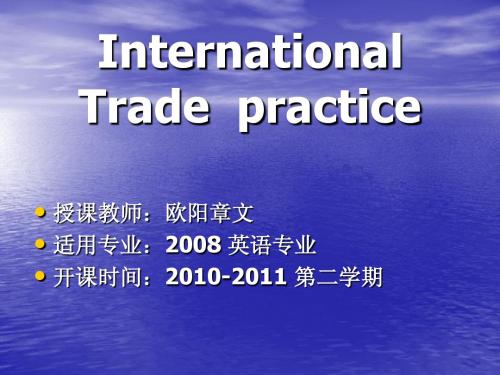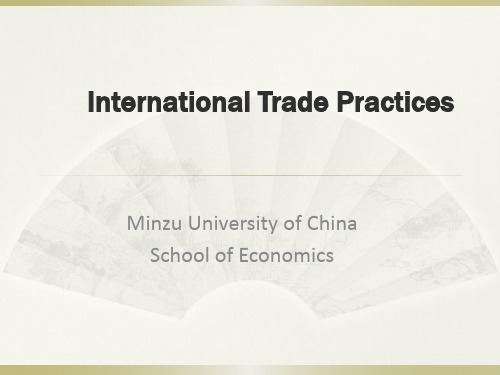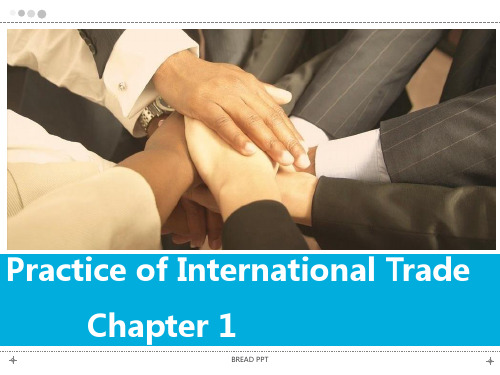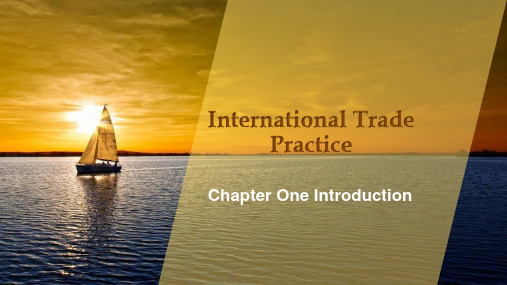英文版国际贸易实务第一课导论
国际贸易实务lesson 1

Figure B:
International Trade
• 1. What is international trade?
• Definition: It refers to the exchange of goods and services Definition:
between nations, also known as international trade or overseas trade.
• A: core idea: national wealth reflected by the holding of idea: • •
precious metal; static view of world resources. B: 2 stages: monetary balance (W. Staffor) and trade balance (T. Mun). C: economic policies : governments controlled the use and exchange of precious metals; prohibition of the export of precious metals of individuals; exports subsidized and quotas and high tariffs placed on imports D: discussion:
2) by trade policy
A. free trade; B. protect trade; C. control trade.
3) by the nature of trading goods
A. tangible/visible goods trade; B. intangible goods trade.
国际贸易实务(英文版)(第四版)(PPT)ppt

Why trade with other nations?
Advantages
International trade leads to more efficient and increased world production, thus allowing countries (and individuals) to consume a larger and more diverse bundle of goods.
Balance of Payments The balance of payment = the difference between money coming into a country and money going out of the country + money flows coming into or leaving a country from other factors. favorable balance of payments VS unfavorable balance of payments
A nation possessing limited natural resources is able to produce and consume more than it otherwise could.
the establishment of international trade expands the number of potential markets in which a country can sell its goods.
Because the balance of payments is one reflection of a nation's financial stability in the world market, the International Monetary Fund (IMF) uses these accounts to make decisions such as qualifying a country for a loan. The IMF also provides the information to its members so that they can make informed decisions about investments and trade.
国际贸易实务01

protect financial stability
for political consideration
key words 1 – tariff barrier
general types of customs tariffs: revenue tariff 财政性关税 protection tariff 保护性关税
invisible hand 无形之手 absolute cost/advantage 绝对成本/优势 ➢ comparative cost/advantage 相对成本/优势 ➢ international specialization 国际分工 factor endowments 要素禀赋
basic reasons for international trade: domestic non-availability of resources principle of comparative advantage
1.1 “resources” & foreign trade
Key words 1: resource (usu. pl.) supply of raw materials, etc. which bring a country, person, etc. wealth. types of resources: ➢ natural resources & human resources ➢ tangible & intangible resources
2. Benefits of International Trade
key words 1: capital goods (生产资料) goods used to produce other goods, e.g. fixed assets like machinery and buildings.
英文版 国际贸易实务第一课 导论

1.2 Why International Trade?
1)Resources reasons (5) Geographical location and transport costs
US VS Canada
EU
BREAD PPT
1.2 Why International Trade?
国际贸易(International Trade)是指不同国家(和/或地 区)之间的商品和劳务的交换活动。 国际贸易是商品和劳务的国际转移。 国际贸易也叫世界贸易。 国际贸易由进口贸易(Import Trade)和出口贸易(Export Trade)两部分组成,故有时也称为进出口贸易。
BREAD PPT
Some concepts:
• Foreign Trade(对外贸易): From the perspective of one country, international trade is also called ‘foreign trade’. • Visible Trade(有形贸易): Trade in goods which can be actually seen passing through ports or airport, entering or leaving one country. • Invisible Trade(无形贸易): Trade in services and technologies
C5 International Trade Terms
C6 International Cargo Transport C7 Cargo Transport Insurance C8 International Payment
International trade英语专业专业必修课 国际贸易实务 英文版 课堂笔记整理

Chapter 1 Introduction to International tradeQuestions & Answers (terms)•International trade(the fair and deliberate exchange of goods and/or services across national boundaries)•Trade in goods (the purchase and sale of visible goods:coffee, chemicals, airplanes, textiles, tobacco)&Trade in services(the purchase and sale of invisible goods: transportation, insurance, tourism, hotel accommodations, commerce)•Self-sufficient (someone who does his own hunting, finds his own shelter, and provides for his own needs)•Barter (the trade of goods without any exchange of money)•Balance of trade (a nation’s rel ationship of exports to imports). A favorable balance of trade, or trade surplus, occurs when the value of the country’s expor ts exceeds that of its imports;An unfavorable balance of trade, or trade deficit, occurs when the value of the country’s imports exceeds that of its exports.•Balance of payments [the difference between money coning into a country (from exports) and money going out of the country (for import) plus money flows coming into or leavinga country from other factors such as tourism, foreign aid.BOP=EM-IM+MF]. Afavorable balance of payments means more money is flowing into a country than flowing out;An unfavorable balance of payments is when more money is flowing out ofa country than coming in.•Dumping(the practic of selling products in foreign country at lower prices than those charged in the producing country). Companies use this tactic to reduce surplus products in foreign markets or to gain a foothold in a new market by offering products for lower prices than domestic competitors do.The foundation of international trade and economic activities:In today’s complex economic world, neither individuals nor nations are self-sufficient. Nations have utilized different economic resources; people have developed different skills.Questions & Answers (text)•What are major reasons of the exchange of goods between nations?✧First, no nation has all of the commodities that it needs.✧Second, a country often does not have enough of a particular item to meet its needs.✧Third, one nation can sell some items at a lower cost than other countries.✧Finally, foreign trade takes place because of innovation or style (fashion).•Why is FDI now more important than trade?✧First, FDI enables host country to build a new manufacturing plant and to payworkers to build it.✧Second, once the plant is operative, it provides both jobs and taxes for host country.✧Third, FDI acts as a catalyst (催化剂) in economic growth for host country.•Why inflows into Sub-Saharan Africa have increased?Tourism is the world's largest industry and every year it pumps billions of dollars into some of the poorest countries in the world. It creates jobs, reduces poverty, builds new roads, airports, hotels and hospitals.•What are major obstacles to Chinese foreign trade?✧Firstly, China should deal with pressure from international markets that aregradually becoming saturated(饱和).✧Secondly, the cost of Chinese exports is increasing, partly because of the highercost of labor and environmental protection.✧Thirdly, increasing international trade protection has caused China to stumble into(陷入)difficult territory.✧Finally, the trade imbalance between China and other countries is getting worse.Chapter 2 Basic Theory of International TradeQuestions & Answers (terms)•Opportunity Cost机会成本:有一得必有一失(the amount of another goods or service that might otherwise have been produced)•Absolute Advantage两者相权取成本低、效率高者[A commodity will be produced in the country where it costs least in terms of resources (capital, land, and labor).] Comparative Advantage两利相权取其重,两劣相权取其轻only one of the goods would work "most best" and "least worse"•What the Theory of C-A Shows if we want to maximize total output in the world then:✧first, fully employ all resources worldwide;✧second, allocate those resources within countries to each country's comparativeadvantage industries;✧third, allow the countries to trade freely .•Specialization (there were some things he was more capable of doing and it would benefit him to concentrate his efforts on the production of those goods in which he was particularly proficient)What are the major benefits of exporting?Why export? Y our general objectives will probably be:To increase profitabilityTo utilise production capacity to the fullThe small domestic market may not big enough for growthYou may be manufacturing a specialised product and find there are not enough customers in SwedenYou may be looking for the increased security your company can achieve by spreading its risks over a variety of marketsYou may want to ensure that your product is kept up to date by exposure to competition in international marketsIt provides scope to develop a company's strengths and abilities. Selling in aninternational environment will sharpen your innovative edge and open up opportunities that might never come your way if you limit yourself to the home market.Michael Porter’s Dia mond ModelMichael Porter of the Harvard Business School introduced a new competitiveness theory, the so-called diamond model. He argues that national prosperity is not inherited, but created by choices; in other words, national wealth is not set by factor endowments, but created by strategic choices. He introduced a concept of “clusters”, or groups of interconnected firms, suppliers,related industries, and institutions that arise in particular locations.1. Firm strategy, Structure and RivalryThe world is dominated by dynamic conditions, and it is direct competition that impels firmsto work for increases in productivity and innovation.2. Demand ConditionsThe more demanding the customers in an economy, the greater the pressure facing firms to constantly to improve their competitiveness via innovative products, through high quality, etc.3. Related Supporting IndustriesUpstream or downstream industries facilitates the exchange of information and promotes a continuous exchange of ideas and innovations.4. Factor ConditionsContrary to conventional wisdoms, Porter argues that the “key” factors of production (or specialized factors) are created, not inherited. Specialized factors are skilled labor, capital and infrastructure. “Non-key” factors or general use factors, such as unskilled labor and raw materials, can be obtained by any company and, hence, do not generate sustained competitive advantage. However, specialized factors involve heavy, sustained investment. They are more difficult to duplicate. This leads to a competitive advantage, because if other firms cannot easily duplicate these factors, they are valuable.The role of government in Porter’ Diamond Model is “acting as a catalyst and challenger; it is to encourage—or even push—companies to raise their aspirations and move to higher levels of competitive performance…”.They must encourage companies to raise their performance, stimulate early demand for advanced products, focus on specialized factors creation and to stimulate local rivalry by limiting direct cooperation and enforce anti-trust(反托拉斯,反垄断)regulations.Chapter 5 International Trade TermsRole of International Trade TermsStanding for specific obligations of the buyer and the seller.Name the exact point at which the ownership of the merchandise is transferred from the seller to the buyer.Define the responsibilities and expenses of both the seller and the buyer.Define the nature of the contract, such as FOB contract or CIF contract, to determine expenses and risks as well as their rights and obligations accordingly.The use of the trade terms greatly simplifies the contract negotiations, and thus saves time and cost.The price of commodity(refers to the unit price, which is made up of a name of currency, a unit price, a measuring unit, a trade term, and a name of destination or shipping place .For example,US$ 800 per M/T CIF London)国际贸易合同的主要条款有: 合同对象(标的):commodities or services 合同总值: total value or quantities 交货条件: trade terms 包装: packaging 装运期: shipment装运口岸和目的地: departure port or destination 保险: insurance 支付条款: payment Procedures of Marine Insurance•To apply for marine insurance;•To determine the insurance value of the goods to be insured;•To determine the insurance average and coverage;•To determine insurance premium;•To sign an insurance policy•To lodge an insurance claim.Proper pricing, complete and accurate quotations, and choice of terms of sale and payment are four critical elements in selling a product or service internationally. Of the four, pricing is the most problematic, even for the experienced exporter.Export product cost structure, involving cost of production, selling and delivery costs, and customs duties.Pricing Considerations•At what price should the firm sell its product in the foreign market?•What type of market positioning does the company want to convey from its pricing structure?•Does the export price reflect the product's quality?•Is the price competitive?•Should the firm pursue market penetration or market-skimming pricing objectives abroad?•What type of discount (trade, cash, quantity) and allowances (advertising, trade-off) should the firm offer its foreign customers?•Laws pose a problem?•Should prices differ by market segment?•What should the firm do about product line pricing?•What pricing options are available if the firm's costs increase or decrease?•Is the demand in the foreign market elastic or inelastic?•Are the prices going to be viewed by the foreign government as reasonable or unfair?•Do the foreign country's antidumping?Pricing Summary Here are the key points to remember when determining your product's price: •Determine the objective in the foreign market.•Compute the actual cost of the export product.•Compute the final consumer price.•Evaluate market demand and competition.•Consider modifying the product to reduce the export price.•Include “non-market" costs, such as tariffs and customs fees.•Exclude cost elements that provide no benefit to the export function, such as domestic advertising.In the cost-plus method of calculation, the exporter starts with the domestic manufacturing cost and adds administration, research and development, overhead, freight forwarding, distributor margins, customs charges, and profit. The effect of this pricing approach may be that the export price escalates into an uncompetitive range.The actual payment= the full invoice of the goods +the additional charges of expenses the seller has paid.Stages in Handling a Bill of Exchange•To draw•Presentation and acceptance•Endorsement•Without recourse•Payment•Dishonor and recourse。
导论 国际贸易实务

Which of the following business belongs to the invisible trade?
A. exporting cars.
B2C B2B
Low transaction cost Integration of business procedures Flexibility Large catalogs Improved customer interactions
Security problem Can’t see the real goods Time lag After-sale services Mail charges
Exporter's preference
Due to the lack of trust between the two parties,the exporter or the importer has his or her own preferences as to how they would like the transaction to be configured (arranged).
20
Form into teams of four or five and discuss the ecommerce revolution. How many students now shop for goods and services online? What have been the experiences? What do you see as the future for such purchases? Prepare a two-minute summary for the class.
英文版国际贸易实务第一课导论

课导论》2023-10-29CATALOGUE 目录•Course Introduction•International Trade Basics •Trade Barriers•Trade Theory and Policies •Case Studies01 Course IntroductionCourse ObjectivesTo introduce students to the basic conceptsand principles of international tradeThe course will be divided intodifferent modules, each focusingon a specific aspect of international trade Course StructureEach module will have a set of learning objectives, readings, case studies, and exercises to help students understand and apply the concepts covered The course will also include a final exam to assess students' understanding and application of the material covered in the courseThe course material will beprovided in English to ensure thatstudents have access to the latestand most comprehensive information on international trade Course MaterialThe material will include textbooks, articles, reports, and case studies to provide students with a broad understanding of the field of international trade The course material will be updated regularly to reflect changes in the global trading system and to incorporate new trade agreements and regulations02 International TradeBasicsDefinition of International TradeInternational TradeExportThe buying and selling of tangiblegoods, such as machinery, electronics, clothing, and food.Forms of International Trade The provision of intangible goods, such as transportation, tourism, education, and financial services.Merchandise tradeService trade Mode of tradeReasons for International Trade Comparative advantages Absolute advantage03 Trade BarriersTariff Barriers定义与类型目的影响Tariff barriers are typicallyimplemented to protect domesticindustries and jobs, as well as toraise revenue for the government.Non-Tariff Barriers定义与类型目的影响Regional Trading Agreements定义目的影响04 Trade Theory andPoliciesComparative Advantage TheoryDefinitionOrigin Components ApplicationDumping and Antidumping MeasuresDefinitionPurpose Methods ControversyExport Subsidies and Countervailing Measures DefinitionPurpose Methods Controversy05 Case Studies总结词:长期、复杂的贸易摩擦,涉及多个领域,对双方经济和全球贸易带来深远影响。
- 1、下载文档前请自行甄别文档内容的完整性,平台不提供额外的编辑、内容补充、找答案等附加服务。
- 2、"仅部分预览"的文档,不可在线预览部分如存在完整性等问题,可反馈申请退款(可完整预览的文档不适用该条件!)。
- 3、如文档侵犯您的权益,请联系客服反馈,我们会尽快为您处理(人工客服工作时间:9:00-18:30)。
英文版国际B贸RE易AD实P务PT第一课导论
Starting from iPhone………
英文版国际B贸RE易AD实P务PT第一课导论
Objectives
✓To master the procedure of International Trade practice ✓To learn how to make required documents ✓To master standard business terms and expressions
国际支付
C9 Inspection/Claims/Force Majeure and Arbitration
检验、索赔、不可抗力和仲裁
C10 Performance of the Contract 进出口合同的履行
英文版国际B贸RE易AD实P务PT第一课导论
1.1 What Is International Trade?
• Question: Is the transaction between the parent company and the two subsidiaries an international trade?
英文版国际B贸RE易AD实P务PT第一课导论
国际性的判断标准
1. 买卖双方当事人的营业地处于不同国家 2. 当事人具有不同的国籍 3. 订立合同的行为完成于不同国家 4. 货物须由一国运往另一国
• Invisible Trade(无形贸易): Trade in services and technologies
英文版国际B贸RE易AD实P务PT第一课导论
Tangible goods
英文版国际B贸RE易AD实P务PT第一课导论
Intangible services
英文版国际B贸RE易AD实P务PT第一课导论
英文版国际B贸RE易AD实P务PT第一课导论
1.2 Why International Trade?
2)Economic reasons (2)The principle of absolute advantage
绝对优势
country
commodity Wine (L/H) Cloth (Y/H)
英文版国际B贸RE易AD实P务PT第一课导论
1.2 Why International Trade?
• Why do countries trade? • Shouldn’t a strong country such as the
United States produce all of the computers, television sets, automobiles and cameras it wants rather than import such products from Japan? • Why do the Japanese and other countries buy wheat, corn, chemical products, aircraft, manufactured goods, and informational services from the United States?
➢国际贸易(International Trade)是指不同国家(和/或地 区)之间的商品和劳务的交换活动。 ➢国际贸易是商品和劳务的国际转移。 ➢国际贸易也叫世界贸易。 ➢国际贸易由进口贸易(Import Trade)和出口贸易(Export Trade)两部分组成,故有时也称为进出口贸易。
英文版国际B贸RE易AD实P务PT第一课导论
The lack of capital------- developing countries are unable to modernize their industries and economies with advanced machinery, equipment, and plant they are not yet able to manufacture.
英文版国际B贸RE易AD实P务PT第一课导论
So you should carefully calculate your cost and benefit and make a wiser choice!
Think of your opportunity cost of studying here?
1.2 Why International Trade?
1)Resources reasons (6) Insufficient production
Only 1.2% labor --------- in food production Importing US$25 billion annually
France England
Some concepts:
• Foreign Trade(对外贸易): From the perspective of one country, international trade is also called ‘foreign trade’.
• Visible Trade(有形贸易): Trade in goods which can be actually seen passing through ports or airport, entering or leaving one country.
Practice of International Trade
Chapter 1
英文版国际B贸RE易AD实P务PT第一课导论
You Are Who You Are
Performance 30%
Attendance 15% Exercises & homework 15%
Final exam 70%
英文版国际B贸RE易AD实P务PT第一课导论
1.2 Why International Trade?
1)Resources reasons
(1) Climate conditions and terrain
• Agricultural produce
Colombia and Brazil
Coffee beans\ coffee
The US Great Plains states 北美中部大平原
A big wheat exporter
英文版国际B贸RE易AD实P务PT第一课导论
1.2 Why International Trade?
1)Resources reasons (2) Natural resources
Middle East : 70% world’s total oil reserve 40% world total output Over 2/3 of the oil that Western Europe and Japan consume
为了得到某种东西而所要放弃另一些东西的最大价值;也可以理解为在面 临多方案择一决策时,被舍弃的选项中的最高价值者是本次决策的机会成 本;还指厂商把相同的生产要素投入到其他行业当中去可以获得的最高收 益。
英文版国际B贸RE易AD实P务PT第一课导论
1.2 Why International Trade?
Case Study
• Suppose that an America-based multinational company set up two subsidiaries in China. The parent company signed a sales contract with the subsidiaries, which stipulated that the parent company would make the delivery to one of the subsidiaries in Shanghai, which should forward some of the goods to another subsidiary at Chengdu.
英文版国际B贸RE易AD实P务PT第一课导论
1.2 Why International Trade?
1)Resources reasons (5) Geographical location and transport costs
US VS Canada
EU
英文版国际B贸RE易AD实P务PT第一课导论
2)Economic reasons (1)Opportunity Cost
Given a choice of producing one product or another, it is more efficient to produce the product with the lower opportunity cost, using the increased production of that product to trade for the product with the higher opportunity cost.
英文版国际B贸RE易AD实P务PT第一课导论
目录CONTENTS
C1 Introduction to International Trade
国际贸易导论
C2 Business Negotiation and Conclusion
of the Contract
交易磋商与合同订立
C3 Quality and Quantity of Goods 商品的品质与数量
英文版国际B贸RE易AD实P务PT第一课导论
1.2 Why International Trade?
1)Resources reasons (3) Technologies and labor
Importing advanced equipment from the US, Japan
